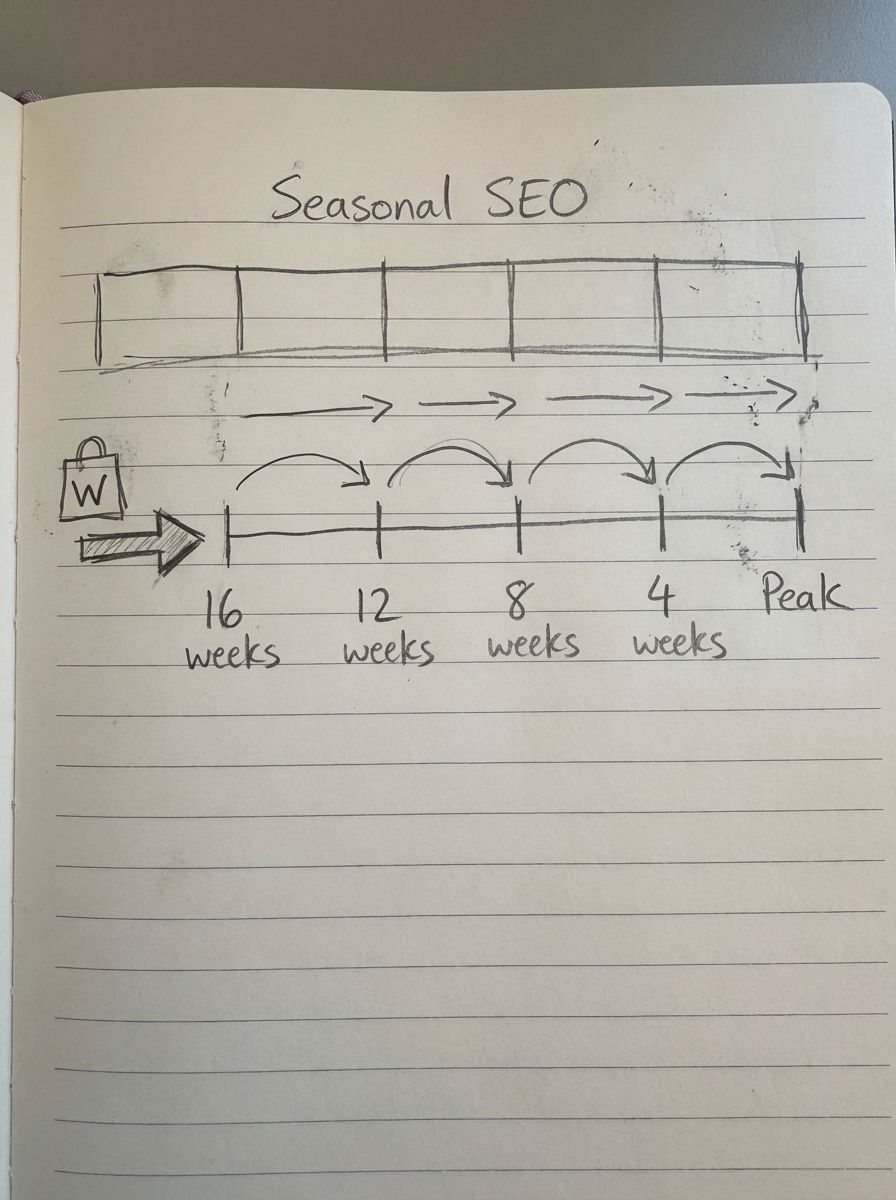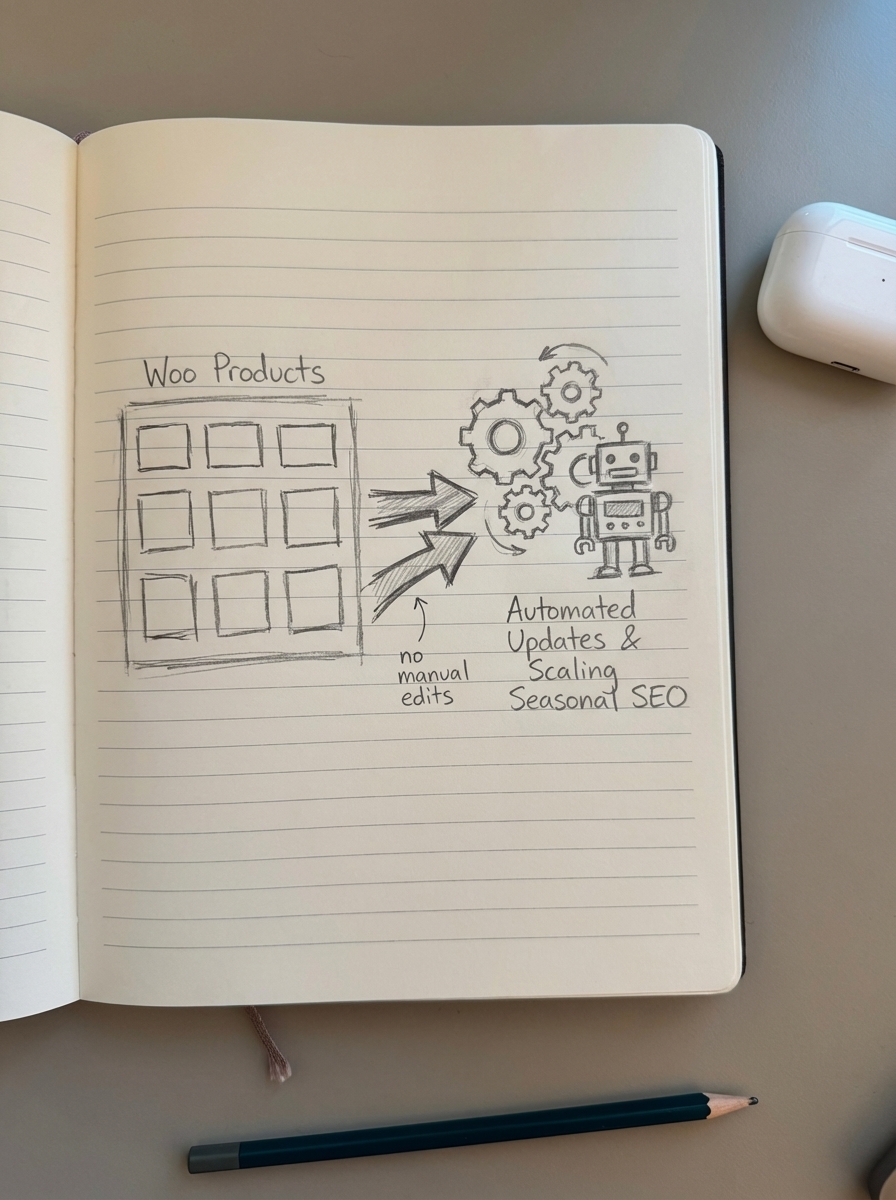Seasonal SEO for WooCommerce: Tactical playbook for holiday and peak-period optimization
Seasonal traffic isn’t bonus revenue – it’s make-or-break for most WooCommerce stores. Stores that prep seasonal SEO 12–16 weeks in advance triple their organic traffic during peak periods, while competitors who wait until November miss the indexation window entirely and watch their traffic flatline.
Most merchants treat seasonal SEO like a promotional push. It’s not. It’s a technical and content operation that requires lead time, disciplined keyword targeting, and catalog-level coordination. This playbook covers the timeline, keyword strategy, category optimization, technical setup, content rollout, and measurement frameworks that turn seasonal demand into predictable revenue.
The seasonal SEO timeline: When to start what
U.S. consumers now start gift searches in September and October to spread out spending. Your content needs to be indexed and ranking before they search. Here’s the timeline that works:

16 weeks before peak season – Pull last year’s GSC data for your seasonal window. Identify high-impression, low-CTR queries. These are your quick wins: pages that Google already trusts but aren’t optimized for clicks. Map seasonal keywords to existing categories versus net-new landing pages. This decision determines your entire content roadmap.
12 weeks out – Implement new category pages or seasonal collections. Begin publishing supporting blog content. Submit updated sitemaps and monitor indexation in GSC. Google needs 2–4 weeks to rank new content; 12 weeks gives you buffer for indexation delays or algorithm updates.
8 weeks out – Optimize on-page elements with seasonal modifiers. Add seasonal schema, especially OfferShippingDetails and Product.offers with validThrough dates. Start building internal links from evergreen content to seasonal pages. This signals to Google that these pages matter for upcoming queries.
4 weeks out – Push your final batch of seasonal blog content. Test site speed under expected traffic load – Black Friday 2024 generated $10.8 billion in U.S. ecommerce sales with traffic spikes 5–10x normal. Validate structured data with Google’s Rich Results Test. One schema error can tank your rich snippet eligibility.
During peak period – Monitor GSC hourly for crawl errors or indexation drops. Track conversions by landing page using an ecommerce SEO dashboard that segments performance by page type. Adjust merchandising based on organic performance, not just paid media signals.
Keyword targeting for seasonal demand
Seasonal keywords fall into three intent buckets, and timing matters. Target the wrong intent at the wrong time, and you burn content budget on traffic that doesn’t convert.

Early research (12+ weeks out) – Queries like “best gifts for [recipient],” “what to buy for [occasion],” and “[product type] guide” drive top-of-funnel traffic. Create buyer guides and how-to content that links to relevant category pages. These pieces build authority early and collect backlinks before competitors wake up.
Mid-funnel comparison (6–8 weeks) – Searchers narrow options with “[product] vs [product],” “affordable [product type],” and “[product] reviews.” Optimize category descriptions with comparison tables and USPs. Use ContentGecko’s free AI SEO content writer to scale product comparison posts that automatically link to your catalog without manual SKU management.
Bottom-funnel transactional (2–4 weeks and peak period) – Queries like “buy [product] online,” “[product] sale,” and “[product] in stock” are your money keywords. Ensure product pages rank by nailing proper structured data, stock availability in schema, clear shipping CTAs, and fundamentals covered in product page SEO best practices.
Run your keyword list through a SERP-based keyword clustering tool to identify which queries share the same top 10 results. Clusters that overlap indicate keywords you can target with one page. Keywords with distinct result sets need dedicated landing pages. This prevents cannibalization and focuses optimization effort where it matters.
Category and collection page optimization
Most stores waste seasonal traffic potential by under-optimizing category pages. A properly optimized seasonal collection can drive 30–40% of your organic revenue during peak periods.
URL structure – Follow clean WooCommerce URL best practices. Use seasonal modifiers only when they improve clarity: /gifts-for-him/ or /holiday-tech-deals/ work. Avoid /shop/category/product-category/gifts-for-him-2024/. Shorter URLs are easier to share, rank faster, and don’t expire psychologically when the year rolls over.
Title tags and meta descriptions – Front-load seasonal intent and differentiators. Title: “Gifts for him under $50 | Free 2-day shipping | [YourStore].” Description: “Shop 200+ gift ideas for him. Same-day dispatch on orders before 3pm. Returns until January 15.” Specificity drives clicks. Vague promises don’t.
On-page content – Google still rewards unique, helpful category descriptions. Write 400–600 words addressing why this category matters this season, common buying questions like “What size should I buy?”, shipping and return deadlines, and gift-specific angles such as wrapping or gift notes. For large catalogs, automate this with an ecommerce category optimizer that generates buyer-friendly titles and descriptions at scale.
Faceted navigation during peak periods – Seasonal demand creates unusual filter combinations: “gifts under $25” or “ships by December 20.” These filters can drive long-tail traffic if you handle them correctly. Use strategic indexation for faceted navigation – index high-demand filter combos based on internal search data and keyword research, canonicalize or noindex low-value combinations, and track filter-specific conversions to validate which combinations warrant dedicated SEO effort. Don’t index every possible filter permutation; you’ll waste crawl budget and create thin content issues.
Technical setup for seasonal scale
Cyber Monday 2024 hit $13.3 billion in U.S. sales. Your infrastructure needs to support 5–10x normal traffic without technical SEO degradation. Speed issues, indexation problems, and schema errors cost you revenue when they happen during peak demand.
Crawl budget management – Seasonal pages compete with your core catalog for crawl budget. Before peak season, audit your XML sitemap to ensure seasonal URLs are prioritized. Use lastmod dates aggressively – update sitemap timestamps when you refresh seasonal content. Block low-value parameter URLs in robots.txt, especially sorting and tracking parameters that create duplicate URL variants.
Canonical tags and duplicate content – Holiday promotions create URL sprawl: /cyber-monday-deals/, /black-friday-sale/, and your regular /on-sale/ category might all show similar products. Pick one canonical seasonal landing page and point variants to it. Review WooCommerce canonical tag best practices and duplicate content prevention strategies to avoid splitting authority across pages that compete with each other.
Structured data for seasonal offers – Standard Product schema isn’t enough during promotional periods. Extend it with shipping and availability signals:
{ "@type": "Product", "offers": { "@type": "Offer", "priceValidUntil": "2025-12-25", "availability": "https://schema.org/InStock", "shippingDetails": { "@type": "OfferShippingDetails", "shippingDestination": { "@type": "DefinedRegion", "addressCountry": "US" }, "deliveryTime": { "@type": "ShippingDeliveryTime", "handlingTime": { "@type": "QuantitativeValue", "minValue": 0, "maxValue": 1, "unitCode": "DAY" } } } }}This signals shipping speed and stock availability directly in SERPs – critical when 63% of Americans shop online for holidays and comparison-shop across multiple tabs. Make sure your schema reflects reality; Google penalizes misleading availability claims.
Mobile optimization – Mobile drives 56.5% of U.S. holiday ecommerce sales. Core Web Vitals matter more during peak periods when users are impatient and have dozens of tabs open. Test mobile LCP, CLS, and INP under peak traffic scenarios using tools like Google PageSpeed Insights or WebPageTest. Most seasonal SEO failures happen because pages that load fine at 100 visitors per hour fall apart at 1,000 visitors per hour. Optimize WooCommerce image SEO with WebP format, lazy loading, and CDN delivery. Images are your biggest mobile bottleneck, and a slow product page loses the sale to the competitor who loads 500ms faster.
Content rollout strategy
Seasonal content has a shelf life. You can’t publish once and forget. Different content types require different publication schedules and maintenance approaches.
Evergreen seasonal content (publish 12–16 weeks early) – Gift guides by recipient type, holiday shopping tips, and product care guides for gift recipients build authority early and collect backlinks. Internal link from these to your seasonal category pages. These pieces work year after year with minor updates; they’re your long-term SEO investment.
Time-sensitive promotional content (publish 4–6 weeks early) – Content like “Black Friday deals preview,” “Early bird shipping deadlines,” and “Last-minute gift ideas” requires precise timing. Google needs 2–4 weeks to rank new content, so don’t publish your “last-minute gifts” guide the week before the holiday. Plan publication dates backward from the event, not forward from when you finish writing.
Real-time inventory and pricing content – This is where automation becomes essential. Manual updates don’t scale when you’re managing hundreds of SKUs across dozens of blog posts and category pages. ContentGecko’s WordPress connector plugin syncs blog content with your WooCommerce catalog in real time. When a product goes out of stock or a price changes, every mention across your content updates automatically. No manual edits, no outdated pricing in gift guides, no customer service headaches from broken promises.
Promotion and link building
On-page SEO gets you in the game. Promotion gets you ranked. You can nail every technical detail and still lose to a competitor who built 20 quality backlinks while you were perfecting your schema.
Internal linking – Use breadcrumb SEO to clarify category hierarchy. Link from evergreen product pages to seasonal collections using contextual anchor text: “Also featured in our holiday gift guide” or “Perfect for Valentine’s Day – see our romance collection.” Internal links pass authority and help Google understand which pages matter for seasonal queries.
Outreach for seasonal roundups – Journalists and bloggers publish annual “best gifts for [X]” roundups. Pitch them in July or August for holiday coverage. Lead with data, not features: “Our [product] saw 340% YoY growth last Q4 among [demographic]” gets a response. “Check out our great product” gets deleted.
User-generated content – Seed seasonal content with early customer reviews. Aggregate them into “Top-rated holiday gifts” collections. These pages naturally attract backlinks from deal sites and social shares. Bonus: reviews improve conversion rates when organic traffic arrives, so you’re building for both SEO and revenue.
Measurement and iteration
You can’t optimize what you don’t measure. Track these KPIs weekly during seasonal ramp-up to catch problems before they cost you revenue.
Organic traffic by page type – Use an ecommerce SEO dashboard to segment category pages (your seasonal collections), product pages (where conversions happen), and blog posts (top-of-funnel traffic drivers). If blog traffic is strong but category traffic is weak, your internal linking needs work. If category traffic converts poorly, your product assortment or on-page messaging is off.
Indexation velocity – Check GSC’s “Pages” report. Are your new seasonal pages indexing within 48 hours? If not, you have a sitemap or crawl budget problem. Google should index priority seasonal pages quickly; delays mean you’re losing ranking runway.
Click-through rate by query – Filter GSC for seasonal keywords. Compare CTR week-over-week. Dropping CTR means competitors improved their SERP presentation or your title and description lost relevance. Test new title tags in batches and measure CTR changes to find winning formulas.
Revenue per keyword cluster – Connect GSC to your analytics. Assign dollar values to keyword clusters. This tells you which seasonal content types actually drive sales versus which just generate traffic. Kill low-converting content types next year; double down on high-converters.
Out-of-stock impact on rankings – Monitor rankings daily for your top 20 seasonal product pages. When products go out of stock, update schema immediately and consider noindexing the page temporarily. Ranking for searches you can’t fulfill wastes crawl budget and damages user experience. When stock returns, re-index fast.
Post-season optimization
The work doesn’t stop when January hits. How you handle post-season cleanup determines next year’s success.
Preserve ranking authority – Don’t delete or noindex seasonal pages after the holiday. Update them with next-year dates and keep them live year-round. A well-established /gifts-for-him/ page from last year will rank faster this year than a brand-new one. Aged domains and aged pages both carry weight in Google’s algorithm.
Analyze what worked – Pull a full seasonal report: which categories drove the most organic revenue, which blog topics got the most engagement, which keyword clusters had the best conversion rates. Document this in a seasonal SEO playbook. Next year’s campaign starts with data, not guesses. I’ve seen stores cut their planning time in half by referencing last year’s performance data instead of starting from scratch.
Update evergreen content – Refresh dates, update pricing, swap out discontinued products. ContentGecko’s AI content writer can automate these updates at scale, ensuring gift guides are always current without manual rewrites.
The automation advantage for large catalogs
Manual seasonal SEO doesn’t scale. Stores with 1,000+ SKUs who try to manually update every product mention across 50+ blog posts and category pages either give up halfway through or miss critical updates. Automation isn’t about cutting corners – it’s about maintaining consistency at scale.

When your inventory changes daily, promotional pricing shifts weekly, and shipping deadlines are date-sensitive, manual updates become a losing battle. ContentGecko handles this by monitoring your WooCommerce catalog for changes, automatically updating product mentions and pricing across all content, maintaining proper schema markup as products go in and out of stock, and generating new seasonal content based on catalog-level trends.
This isn’t “set it and forget it.” It’s “set it and scale it.” You still own the strategy – what to target, when to publish, which products to feature. The platform handles the execution grunt work that bogs down most seasonal campaigns.
TL;DR
Seasonal SEO for WooCommerce requires 12–16 weeks of lead time, not last-minute promotions. Start with keyword research using SERP-based clustering to identify which queries need dedicated pages. Optimize category pages with seasonal modifiers, unique content, and strategic faceted navigation. Extend your structured data to include shipping deadlines and promotional pricing. Roll out content in waves: evergreen guides first (12+ weeks), time-sensitive content next (4–6 weeks), then real-time inventory updates. Measure traffic by page type, indexation speed, and revenue per keyword cluster. For catalogs over 500 products, manual updates don’t scale – automation keeps seasonal content accurate without the operational overhead.
